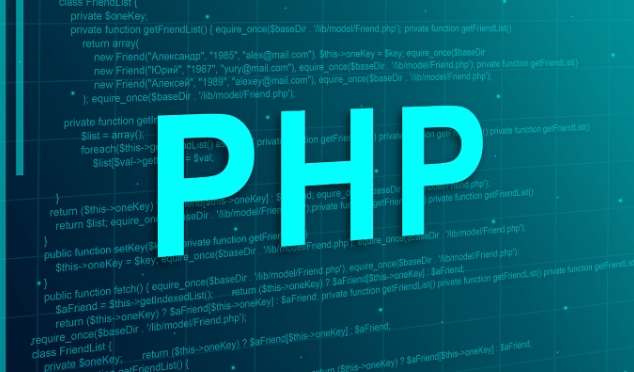PHP's POST request needs to be paid attention to security issues. Key points include: 1. Verify user input to prevent injection attacks, use preprocessing statements, casting and filtering functions; 2. Add CSRF protection mechanisms, such as one-time tokens and checking HTTP_REFERER headers; 3. Strictly limit file upload functions, check MIME types, extensions, and file header information, and prohibit execution of scripts; 4. However, trust HTTP methods or sources, authenticate and authenticate all sensitive operations. These measures can effectively improve safety.

PHP's POST request itself is a common way to process form data, API interfaces, etc., but if used improperly, it can easily become an entry point for security vulnerabilities. Many websites are attacked often start with a seemingly ordinary POST request. The following key points are what you must pay attention to when processing POST data in PHP.

1. Not verifying user input leads to injection attacks
If the data transmitted from POST request is not filtered and verified, it is directly used for database query, system command execution and other operations, which is very easy to cause problems such as SQL injection and command injection.

suggestion:
- Never splice the value of
$_POSTdirectly into SQL or shell commands - Use preprocessing statements such as PDO to prevent SQL injection
- For fields of numeric types, cast (such as
(int)$_POST['id']) - Filter strings, such as using
htmlspecialchars()orfilter_var()
For example:

$stmt = $pdo->prepare('INSERT INTO users (name, email) VALUES (?, ?)'); $stmt->execute([$_POST['name'], $_POST['email']]);
In this way, even if the user submits malicious content, it will not be executed directly.
2. Lack of CSRF protection mechanism
CSRF (cross-site request forgery) is a common attack method. The attacker induces the user to access a link or image and secretly initiates a POST request to your website, such as password modification, transfer and other sensitive operations.
suggestion:
- Add a one-time token to form or interface for all important operations
- Each time a token is generated, the session is stored and verified when submitting
- Set the SameSite cookie attribute to
StrictorLax - Check the
HTTP_REFERERheader (although it is not omnipotent, it can add a layer of protection)
A simple token verification process:
// Generate tokens
$_SESSION['token'] = bin2hex(random_bytes(50));
// Add hidden fields to the form echo '<input type="hidden" name="token" value="' . $_SESSION['token'] . '">';
// Verify when submitting if (!isset($_POST['token']) || $_POST['token'] !== $_SESSION['token']) {
die('illegal request');
}3. The file upload function is not designed rigorously
Many websites allow users to upload files through POST. If the restrictions are not strict enough, attackers may upload script files such as .php and .phtml to gain server control permissions.
suggestion:
- Do not rely on the client to detect file types (such as JS judgment)
- The server must check the MIME type, extension, and file header information
- Set the upload directory to non-executable PHP scripts (such as configuring
.htaccessor Nginx rules) - File names should be randomized as much as possible to avoid user control
For example, a method to check the extension:
$allowed = ['jpg', 'jpeg', 'png', 'gif'];
$ext = pathinfo($_FILES['file']['name'], PATHINFO_EXTENSION);
if (!in_array(strtolower($ext), $allowed)) {
die('not allowed file types');
}4. Over-trust HTTP methods or sources
Some people think that only the front-end page they write will send POST requests, but in fact anyone can simulate POST requests through tools. For example, use Postman or curl to send any parameters.
suggestion:
- Don't just rely on whether it is a POST request to determine security
- All sensitive operations must be authenticated (such as login status, permission check)
- When using API interfaces, add authentication mechanisms (such as JWT, API Key)
- Logging suspicious behavior, such as large number of requests in a short period of time
For example, simple login verification logic:
if ($_SERVER['REQUEST_METHOD'] === 'POST') {
if (!is_user_logged_in()) {
http_response_code(401);
echo json_encode(['error' => 'Unauthorized']);
exit;
}
// Normal processing logic}These security issues seem common, but are often overlooked in actual development. Many people think that "it's just a POST request", but they leave a big pit. In fact, as long as you develop good habits, such as verifying input, using security functions, adding tokens, restricting uploads, etc., you can avoid most risks.
Basically that's it.
The above is the detailed content of php post security vulnerabilities. For more information, please follow other related articles on the PHP Chinese website!

Hot AI Tools

Undress AI Tool
Undress images for free

Undresser.AI Undress
AI-powered app for creating realistic nude photos

AI Clothes Remover
Online AI tool for removing clothes from photos.

Clothoff.io
AI clothes remover

Video Face Swap
Swap faces in any video effortlessly with our completely free AI face swap tool!

Hot Article

Hot Tools

Notepad++7.3.1
Easy-to-use and free code editor

SublimeText3 Chinese version
Chinese version, very easy to use

Zend Studio 13.0.1
Powerful PHP integrated development environment

Dreamweaver CS6
Visual web development tools

SublimeText3 Mac version
God-level code editing software (SublimeText3)
 PHP Variable Scope Explained
Jul 17, 2025 am 04:16 AM
PHP Variable Scope Explained
Jul 17, 2025 am 04:16 AM
Common problems and solutions for PHP variable scope include: 1. The global variable cannot be accessed within the function, and it needs to be passed in using the global keyword or parameter; 2. The static variable is declared with static, and it is only initialized once and the value is maintained between multiple calls; 3. Hyperglobal variables such as $_GET and $_POST can be used directly in any scope, but you need to pay attention to safe filtering; 4. Anonymous functions need to introduce parent scope variables through the use keyword, and when modifying external variables, you need to pass a reference. Mastering these rules can help avoid errors and improve code stability.
 How to handle File Uploads securely in PHP?
Jul 08, 2025 am 02:37 AM
How to handle File Uploads securely in PHP?
Jul 08, 2025 am 02:37 AM
To safely handle PHP file uploads, you need to verify the source and type, control the file name and path, set server restrictions, and process media files twice. 1. Verify the upload source to prevent CSRF through token and detect the real MIME type through finfo_file using whitelist control; 2. Rename the file to a random string and determine the extension to store it in a non-Web directory according to the detection type; 3. PHP configuration limits the upload size and temporary directory Nginx/Apache prohibits access to the upload directory; 4. The GD library resaves the pictures to clear potential malicious data.
 Commenting Out Code in PHP
Jul 18, 2025 am 04:57 AM
Commenting Out Code in PHP
Jul 18, 2025 am 04:57 AM
There are three common methods for PHP comment code: 1. Use // or # to block one line of code, and it is recommended to use //; 2. Use /.../ to wrap code blocks with multiple lines, which cannot be nested but can be crossed; 3. Combination skills comments such as using /if(){}/ to control logic blocks, or to improve efficiency with editor shortcut keys, you should pay attention to closing symbols and avoid nesting when using them.
 Tips for Writing PHP Comments
Jul 18, 2025 am 04:51 AM
Tips for Writing PHP Comments
Jul 18, 2025 am 04:51 AM
The key to writing PHP comments is to clarify the purpose and specifications. Comments should explain "why" rather than "what was done", avoiding redundancy or too simplicity. 1. Use a unified format, such as docblock (/*/) for class and method descriptions to improve readability and tool compatibility; 2. Emphasize the reasons behind the logic, such as why JS jumps need to be output manually; 3. Add an overview description before complex code, describe the process in steps, and help understand the overall idea; 4. Use TODO and FIXME rationally to mark to-do items and problems to facilitate subsequent tracking and collaboration. Good annotations can reduce communication costs and improve code maintenance efficiency.
 How Do Generators Work in PHP?
Jul 11, 2025 am 03:12 AM
How Do Generators Work in PHP?
Jul 11, 2025 am 03:12 AM
AgeneratorinPHPisamemory-efficientwaytoiterateoverlargedatasetsbyyieldingvaluesoneatatimeinsteadofreturningthemallatonce.1.Generatorsusetheyieldkeywordtoproducevaluesondemand,reducingmemoryusage.2.Theyareusefulforhandlingbigloops,readinglargefiles,or
 Learning PHP: A Beginner's Guide
Jul 18, 2025 am 04:54 AM
Learning PHP: A Beginner's Guide
Jul 18, 2025 am 04:54 AM
TolearnPHPeffectively,startbysettingupalocalserverenvironmentusingtoolslikeXAMPPandacodeeditorlikeVSCode.1)InstallXAMPPforApache,MySQL,andPHP.2)Useacodeeditorforsyntaxsupport.3)TestyoursetupwithasimplePHPfile.Next,learnPHPbasicsincludingvariables,ech
 How to access a character in a string by index in PHP
Jul 12, 2025 am 03:15 AM
How to access a character in a string by index in PHP
Jul 12, 2025 am 03:15 AM
In PHP, you can use square brackets or curly braces to obtain string specific index characters, but square brackets are recommended; the index starts from 0, and the access outside the range returns a null value and cannot be assigned a value; mb_substr is required to handle multi-byte characters. For example: $str="hello";echo$str[0]; output h; and Chinese characters such as mb_substr($str,1,1) need to obtain the correct result; in actual applications, the length of the string should be checked before looping, dynamic strings need to be verified for validity, and multilingual projects recommend using multi-byte security functions uniformly.
 Quick PHP Installation Tutorial
Jul 18, 2025 am 04:52 AM
Quick PHP Installation Tutorial
Jul 18, 2025 am 04:52 AM
ToinstallPHPquickly,useXAMPPonWindowsorHomebrewonmacOS.1.OnWindows,downloadandinstallXAMPP,selectcomponents,startApache,andplacefilesinhtdocs.2.Alternatively,manuallyinstallPHPfromphp.netandsetupaserverlikeApache.3.OnmacOS,installHomebrew,thenrun'bre






